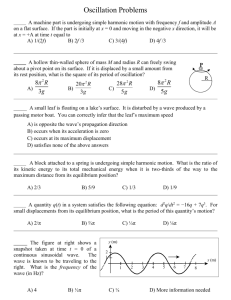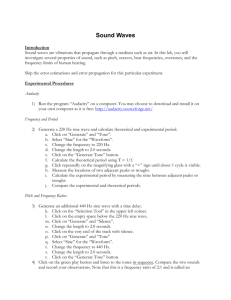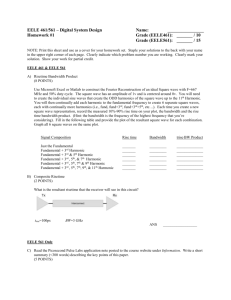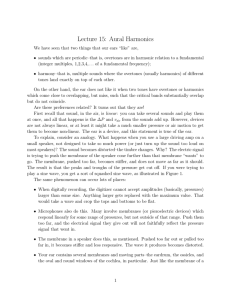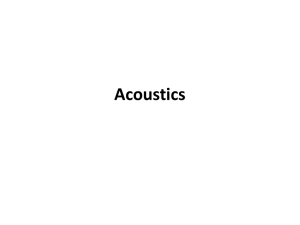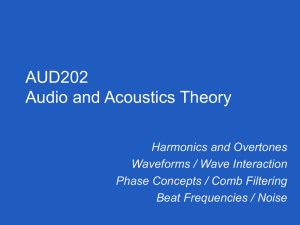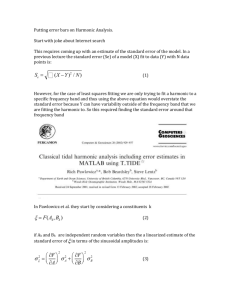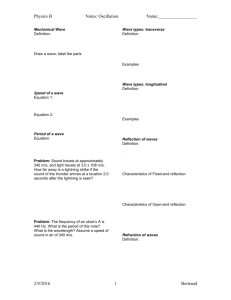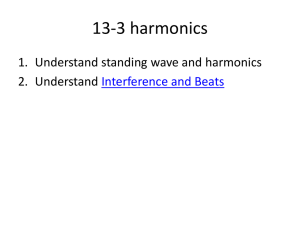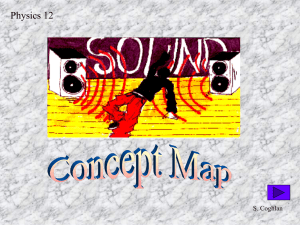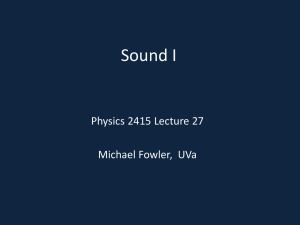Music and Mathematics
advertisement
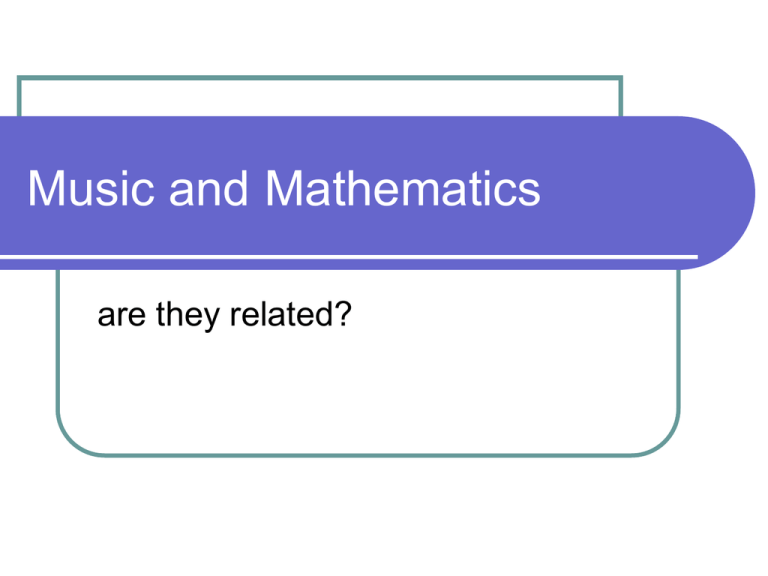
Music and Mathematics are they related? What is Sound? Sound consists of vibrations of the air. In the air there are a large number of molecules moving around at about 1000 mph colliding into each other. The collision of the air molecules is perceived as air pressure. When an object vibrates it causes waves of increased and decreased pressure in the air, which are perceived by the human ear as sound. Sound travels through the air at about 760 mph. (That is, the local disturbance of the pressure propagates at this speed). Four Attributes of Sound Amplitude—the size of the vibration and the perceived loudness. Pitch—corresponds to the frequency of vibration (measured in Hertz (Hz) or cycles per second). Duration—the length of time for which the note sounds. Timbre—the quality of the musical note. Timbre Imagine a note played by banging a stick on an aluminum can, then imagine the same note being played on a guitar string. Although the amplitude, pitch and duration may all be the same, there is a discernible difference to the ear of the quality of the note each “instrument” produced; this is timbre. Visual Picture of Sound Mathematically these attributes can be pictured by a sine wave as illustrated. This picture illustrates one cycle of the sine wave. The Amplitude (or height) of the wave is the maximum y value (in this case one); the higher the amplitude, the louder the sound. •If the x axis represents time, this wave has a frequency of 1/6 cycle per second. This sound would not be audible to the human ear. •The length of the wave, in this case just over 6 seconds, gives the duration of the sound. A 20 Hz Sound The picture below shows a 20 Hz sound wave lasting for 1 second. If you count the cycles you will see that there are 20 cycles of the sine wave in this one second interval. Example Example 1: Look at the pictures representing sound waves below. Which sound would be louder? Which has the highest pitch? Which would sound the longest? The 440 Hz sound (A note) Fundamental Frequency and Overtones Although we talk about a frequency of an individual sound wave, most vibrations consist of more than one frequency. If, for example, an A is played on a guitar string, a frequency of 440 Hz, then the string is muted other sounds can still be heard, these are the other frequencies that play simultaneously with the 440 Hz frequency. The 440 Hz frequency in this example would be called the fundamental frequency, the other frequencies heard are called overtones. Sum of Sine waves (Fundamental + Overtones) Harmonics An integer multiple of the fundamental frequency is called a harmonic. The first harmonic is the fundamental frequency, the second harmonic is twice the fundamental frequency, the third harmonic is 3 times the fundamental frequency and so on. For example, if the fundamental frequency is 100 Hz, then the second harmonic is 200 Hz, the third is 300 Hz, etc. Harmonics as Overtones Recall that on most instruments, like a guitar, there are overtones that sound out with the fundamental frequency. These overtones are higher pitched, which would mean they have shorter wave lengths, since there are more cycles per second (Hz). The overtones are actually the different harmonics. The wave lengths are 1/2, 1/3, 1/4, 1/5, 1/6, etc. the wavelength of the fundamental frequency. (see illustration on next slide) Illustration The Harmonic Series Notice that one cycle of the sine wave is 1/2, 1/3, and 1/4 the fundamental frequency for the 2nd, 3rd, and 4th harmonics respectively. In mathematics the sum 1 + 1/2 + 1/3 + 1/4 + 1 1/5 + … (denoted by n ) is called the harmonic series. In mathematics the harmonic series diverges; so what does this mean musically? n 1 Example Example 4: If Sound A is the fundamental frequency, then which harmonic is Sound B? What is the frequency of each sound? The 12-tone (chromatic) Scale On a 12-tone scale the frequency separating each tone is called a halfstep. These half steps correspond to keys on the piano keyboard as illustrated below: Ratio of Frequencies to the Fundamental Frequency. Each half step is separated by a common multiplicative factor, say f; that is Cf =C#, C#f =D, etc. So, from C to C we’ve increased the frequency by a factor of f 12 times or by f12. Since we know that the second C is an octave above the first, that means its frequency has doubled, hence f12 = 2. 12 Consequently f = 2 . Table of Frequencies If we accept that middle C has a frequency of 261.6 Hz, then we can find the frequencies of all the notes in a 12-tone scale by successively multiplying by 12 2 ; see table to the right. Note Frequency (in Hz) (rounded) Ratio to Frequency of Middle C C 262 1 C# 277 1.05946 D (second) 294 1.12246 D# 311 1.18921 E (third) 330 1.25992 5/4 F (fourth) 349 1.33483 4/3 F# 370 1.414214 G (fifth) 392 1.498307 3/2 G# 415 1.58740 A (sixth) 440 1.68179 5/3 A# 466 1.78180 B (seventh) 494 1.88775 C (octave) 524 2 Major Scales A major scale consists of 8 notes. The major C scale is C-D-E-F-G-A-B-C. Notice that between C and D are two half-steps, or a “whole-step,” and between D and E is a whole-step, but between E and F it’s only a half-step (refer to keyboard picture). The next step from F to G is a whole-step, G to A is a whole-step, A to B is a whole-step, and then from B to C is another half-step. So we see the pattern for a major scale; starting at any note we will take a whole-step, whole-step, half-step, whole-step, whole-step, whole-step, half-step. Example Example: Find the notes in the major A scale. Minor Scales The pattern for minor Scales starting from the fundamental note: Whole step, half step, whole step whole step, half step, whole step whole step Example: Find the notes in an A-minor (Am) Scale. Relative Minors The major C scale is C-D-E-F-G-A-B-C The A minor Scale is A-B-C-D-E-F-G-A Notice the same notes in both scales but in a different order Thus, Am is called the “relative minor” of C. Relative minor chords have a “similar sound” Contact Information Angie Schirck-Matthews Broward College Mathematics Central Campus 3501 SW Davie Road, Davie FL 33314 Office: 954.201.4918 Cell: 954.249.5331 Email: amatthew@broward.edu
